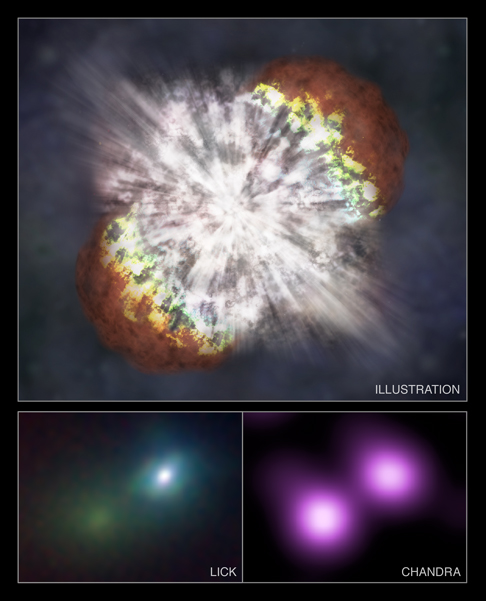
 Credit: NASA/CXC/M.Weiss; X-ray: NASA/CXC/UC Berkeley/N.Smith et al.; IR: Lick/UC Berkeley/J.Bloom & C.Hansen
Credit: NASA/CXC/M.Weiss; X-ray: NASA/CXC/UC Berkeley/N.Smith et al.; IR: Lick/UC Berkeley/J.Bloom & C.Hansen
Does 2006gy = 2007 Eta Car?
The chances that Eta Carinae, the nearest supermassive star, will explode within the next year are extremely remote. But the chances have slightly improved since 2006. In September 2006 astronomers detected a distant flash of light which they dubbed SN 2006gy. It was not the brightest supernova - the Crab supernova, SN 1054, was so bright it could be seen in the daytime. Still, it peaked the interest of astronomers, since it remained near maximum luminosity for almost 100 days and it belongs to the galaxy NGC 1260, about 238 million light years from earth. The supernova must have been extremely luminous, about 10 times more luminous than "normal" supernovae. The image above shows an artist conception of what the explosion might have looked like; the lower left image shows a Lick Observatory infrared picture of the core of NGC 1260 with the supernova the bright object to the upper right of the core. The image on the lower right is a Chandra X-ray Observatory image of NGC 1260, showing X-ray emission from both the core of NGC 1260 and SN 2006gy. These observations suggest that the exploded star must have been extremely massive and must have suffered substantial episodes of mass ejection. Eta Carinae, only about 8500 light years away, has similar properties. When will it go? Keep watching.
<
HEA Dictionary ● Archive
● Search HEAPOW
● Other Languages
● HEAPOW on Facebook
● Download all Images
● Education ● HEAD
>
Each week the HEASARC
brings you new, exciting and beautiful images from X-ray and Gamma ray
astronomy. Check back each week and be sure to check out the HEAPOW archive!
Page Author: Dr. Michael F. Corcoran
Last modified Tuesday, 27-Feb-2024 10:15:21 EST


